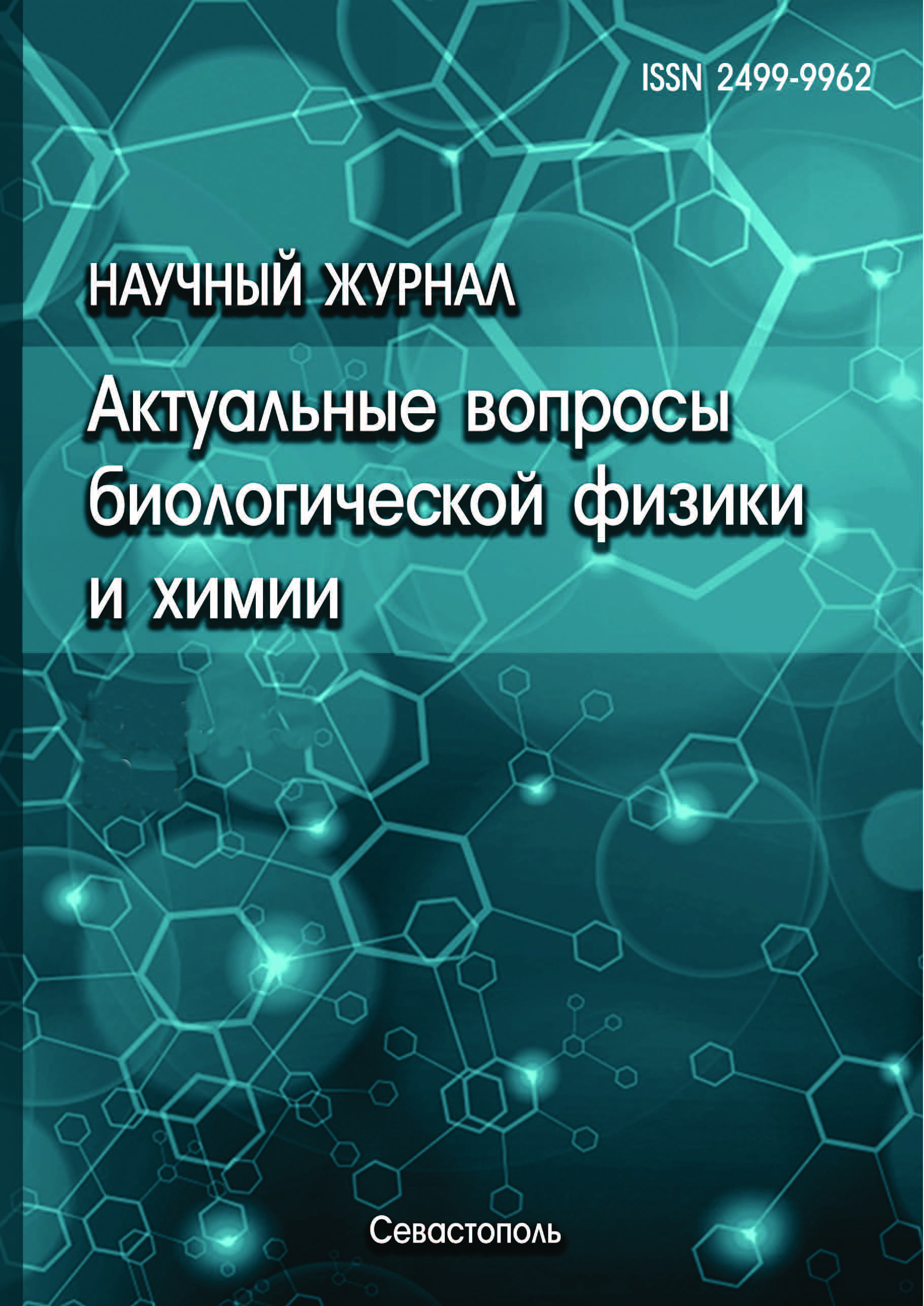Sevastopol, Sevastopol, Russian Federation
Sevastopol State University
Sevastopol, Sevastopol, Russian Federation
Sevastopol, Sevastopol, Russian Federation
Sevastopol, Sevastopol, Russian Federation
Sevastopol, Sevastopol, Russian Federation
The vibronic absorption spectrum of Toluidine blue O (TBO) dye in an aqueous solution was calculated using the time-dependent density functional theory (TD-DFT). The calculations were performed using all hybrid functionals supported by Gaussian16 software and 6-31++G(d,p) basis set with IEFPCM and SMD solvent models. The IEFPCM gave underestimated values of λmax in comparison with the experiment, what is a manifestation of the TD-DFT "cyanine failure". However, the SMD made it possible to obtain good agreement between calculated and experimental spectra. The best fit was achieved using the X3LYP functional. The dipole moments and atomic charges of the ground and excited states of the TBO molecule were calculated. Photoexcitation leads to an increase in the dipole moment of the dye molecule. An insignificant photoinduced electron transfer was found in the central ring of the chromophore of the TBO molecule. Vibronic transitions play a significant role in the absorption spectrum of the dye.
Toluidine blue O, aqueous solution, vibronic absorption spectrum, time-dependent density functional theory, electronic properties
1. Fekrazad R., Zare H., Mohammadi S., Vand S. Photodynamic therapy effect on cell growth inhibition induced by Radachlorin and toluidine blue O on Staphylococcus aureus and Escherichia coli: An in vitro study, Photodiagn. Photodyn. Ther., 2016, vol. 15, pp. 213-217, doi:https://doi.org/10.1016/j.pdpdt.2016.07.001. EDN: https://elibrary.ru/WSSGMN
2. Anju V.T., Paramanantham P., Lal S.B.S., Sharan A., Syed A., Bahkali N.A., Alsaedi M.H., Kaviyarasu K., Busi S. Antimicrobial photodynamic activity of toluidine blue-carbon nanotube conjugate against Pseudomonas aeruginosa and Staphylococcus aureus - Understanding the mechanism of action. Photodiagn. Photodyn. Ther., 2019, vol. 27, pp. 305-316, doi:https://doi.org/10.1016/j.pdpdt.2019.06.014.
3. Moslemi N., Rouzmeh N., Shakerinia F., Bahador A., Azar P.S., Kharazifard M.J., Paknejad M., Fekrazad R. Photodynamic Inactivation of Porphyromonas gingivalis utilizing Radachlorin and Toluidine Blue O as Photosensitizers: An In Vitro Study. J. Lasers Med. Sci., 2018, vol. 9, pp. 107-112, doi:https://doi.org/10.15171/jlms.2018.21.
4. Parasuraman P., Antony A.P., Lal S.B.S., Sharan A., Siddhardha B., Kasinathan K., Bahkali N.A., Dawoud T.M.S., Syed A. Antimicrobial photodynamic activity of toluidine blue encapsulated in mesoporous silica nanoparticles against Pseudomonas aeruginosa and Staphylococcus aureus. Biofouling, 2019, vol. 35, pp. 89-103, doi:https://doi.org/10.1080/08927014.2019.1570501.
5. Almeida A.M., Oliveira O.N., Aoki P.H.B. Role of Toluidine Blue- O Binding Mechanism for Photooxidation in Bioinspired Bacterial Membranes. Langmuir, 2019, vol. 35, pp. 16745-16751, doi:https://doi.org/10.1021/acs.langmuir.9b03045.
6. Misba L., Kulshrestha S., Khan A.U. Antibiofilm action of a toluidine blue O-silver nanoparticle conjugate on Streptococcus mutans: a mechanism of type I photodynamic therapy. Biofouling, 2016, vol. 32, pp. 313-328, doi:https://doi.org/10.1080/08927014.2016.1141899. EDN: https://elibrary.ru/XQIEML
7. Wainwright M., O'Kane C., Rawthore S. Phenothiazinium photosensitisers XI. Improved toluidine blue photoantimicrobials. J. Photochem. Photobiol. B, 2016, vol. 160, pp. 68-71, doi:https://doi.org/10.1016/j.jphotobiol.2016.03.035.
8. Rolim J.P.M.L., de-Melo M.A.S., Guedes S.F., Albuquerque-Filho F.B., de Souza J.R., Nogueira N.A.P., Zanin I.C.J., Rodrigues L.K.A. The antimicrobial activity of photodynamic therapy against Streptococcus mutans using different photosensitizers. J. Photochem. Photobiol. B, 2012, vol. 106, pp. 40-46, doi:https://doi.org/10.1016/j.jphotobiol.2011.10.001.
9. Drzymala R.E., Liebman P.A., Romhanyi G. Acid Polysaccharide Content of Frog Rod Outer Segments Determined by metachromatic Toluidine Blue Staining. Histochemistry, 1982, vol. 76, pp. 363-379, doi:https://doi.org/10.1007/BF00543958. EDN: https://elibrary.ru/RHAVUT
10. Bastos A.L., Marques D.V., da Silva J.F., Nunes J.B.M., Correia A.D., Vigariox J.D., Terrinha A.M. Primary Inducible Fluorescence in Secretory Granules of Tumor Cells Supravitally Stained by a Toluidine Blue Dye. Z. Naturforschg, 1968, vol. 23b, pp. 969-975, doi:https://doi.org/10.1515/znb-1968-0716.
11. Sridharan G., Shankar A.A. Toluidine blue: A review of its chemistry and clinical utility. J. Oral Maxillofac. Pathol., 2012, vol. 16, pp. 251-255, doi:https://doi.org/10.4103/0973-029X.99081.
12. Li X., Yuan R., Chai Y., Zhang L., Zhuo Y., Zhang Y. Amperometric immunosensor based on toluidine blue/nano-Au through electrostatic interaction for determination of carcinoembryonic antigen. J. Biotechnol., 2006, vol. 123, pp. 356-366, doi:https://doi.org/10.1016/j.jbiotec.2005.11.023. EDN: https://elibrary.ru/MAAAFR
13. Bai X., Chen G., Shiu K.-K. Electrochemical biosensor based on reduced graphene oxide modified electrode with Prussian blue and poly(toluidine blue O) coating. Electrochim. Acta, 2013, vol. 89, pp. 454-460, doi:https://doi.org/10.1016/j.electacta.2012.11.086. EDN: https://elibrary.ru/RLKMZT
14. Gao H.-W., Qin P., Lin C., Shang Z.-M., Sun W. Electrochemical DNA Biosensor for the Detection of Listeria Monocytogenes Using Toluidine Blue as a Hybridization Indicator. J. Iran. Chem. Soc., 2010, vol. 7, pp. 119-127, doi:https://doi.org/10.1007/BF03245868. EDN: https://elibrary.ru/YXBQYO
15. Liu M., Zhang G.Shi.L., Zhao G., Jin L. Electrode modified with toluidine blue-doped silica nanoparticles, and its use for enhanced amperometric sensing of hemoglobin. Anal. Bioanal. Chem., 2008, vol. 391, pp. 1951-1959, doi:https://doi.org/10.1007/s00216-008-2103-z. EDN: https://elibrary.ru/MJDYMJ
16. Gligor D., Walcarius A. Glassy carbon electrode modified with a film of poly(Toluidine Blue O) and carbon nanotubes for nitrite detection. J. Solid State Electrochem., 2014, vol. 18, pp. 1519-1528, doi:https://doi.org/10.1007/s10008-013-2365-z. EDN: https://elibrary.ru/TOCEXD
17. Zeyada H.M., Youssif M.I., El- Ghamaz N.A., Nasher M.A. Carrier transport mechanisms and photovoltaic characteristics of Au/toluidine blue/n-Si/Al heterojunction solar cell. J. Mater. Sci.: Mater. Electronics, 2018, vol. 29, pp. 3592-3601, doi:https://doi.org/10.1007/s10854-017-8289-0. EDN: https://elibrary.ru/YFDDHF
18. Viswanath V., Nair S.S., Subodh G., Muneera C.I. Emission features, surface morphology and optical limiting properties of semiconducting Toluidine Blue O dye- poly(vinyl alcohol) nanocomposite architecture. SN Appl. Sci., 2019, vol. 1, no. 43, doi:https://doi.org/10.1007/s42452-018-0043-6.
19. Dubey T., Gorantla N.V., Chandrashekara K.T., Chinnathambi S. Photoexcited Toluidine Blue Inhibits Tau Aggregation in Alzheimer’s Disease. ACS Omega, 2019, vol. 4, pp. 18793-18802. doi:https://doi.org/10.1021/acsomega.9b02792.
20. Ilanchelian M., Ramaraj R. Binding Interactions of Toluidine Blue O with Escherichia Coli DNA: Formation of Bridged Structure. J. Fluoresc., 2011, vol. 21, pp. 1439-1453, doi:https://doi.org/10.1007/s10895- 010-0829-4. DOI: https://doi.org/10.1007/s10895-010-0829-4; EDN: https://elibrary.ru/CXUSVR
21. Sato S., Matsumoto S., Freivalds T., Erenpreisa J. Consideration on the Metachromatic Spectra of Toluidine Blue Dimers Formed on DNA Oligomers. Bull. Chem. Soc. Jpn., 2010, vol. 83, pp. 1216-1222, doi:https://doi.org/10.1246/bcsj.20100032. EDN: https://elibrary.ru/OBVWHT
22. Chi Z., Liu R., Sun Y., Wang M., Zhang P., Gao C. Investigation on the toxic interaction of toluidine blue with calf thymus DNA. J. Hazard. Mater., 2010, vol. 175, pp. 274-278, doi:https://doi.org/10.1016/j.jhazmat.2009.09.160.
23. Wang J., Yang X. Multiplex binding modes of toluidine blue with calf thymus DNA and conformational transition of DNA revealed by spectroscopic studies. Spectrochim. Acta A, 2009, vol. 74, pp. 421-426, doi:https://doi.org/10.1016/j.saa.2009.06.038. EDN: https://elibrary.ru/XXIZVD
24. Paul P., Kumar G.S. Thermodynamics of the DNA binding of phenothiazinium dyes toluidine blue O, azure A and azure B. J. Chem. Thermodynamics, 2013, vol. 64, pp. 50-57, doi:https://doi.org/10.1016/j.jct.2013.04.023. EDN: https://elibrary.ru/YAMDMR
25. Chen L.-H., Nie Y.-T., Liu L.-Z., Shen H.-X. Determination of Nucleic Acids on the Basis of Enhancement Effect of Resonance Light Scattering of Toluidine Blue. Anal. Lett., 2003, vol. 36, pp. 107-122, doi:https://doi.org/10.1081/AL-120017266.
26. Paul P., Mati S.S., Bhattacharya S.C., Kumar G.S. Spectroscopic, calorimetric, cyclic voltammetric and molecular modeling studies of new methylene blue-polyadenylic acid interaction and comparison to thionine and toluidine blue O: Understanding self-structure formation by planar dyes. Dyes Pigments, 2017, vol. 136, pp. 205-218, doi:https://doi.org/10.1016/j.dyepig.2016.08.027.
27. Paul P., Kumar G.S. Targeting ribonucleic acids by toxic small molecules: Structural perturbation and energetics of interaction of phenothiazinium dyes thionine and toluidine blue O to tRNAphe. J. Hazard. Mater., 2013, vol. 263, pp. 735-745, doi:https://doi.org/10.1016/j.jhazmat.2013.10.040.
28. Liu J., Zou A., Mu B. Toluidine blue: Aggregation properties and distribution behavior in surfactin micelle solution. Colloids Surfaces B, 2010, vol. 75, pp. 496-500, doi:https://doi.org/10.1016/j.colsurfb.2009.09.025.
29. Shanmugaraj K., Umadevi P., Senthilkumar L., Ilanchelian M. Elucidation of binding mechanism of photodynamic therapeutic agent toluidine blue O with chicken egg white lysozyme by spectroscopic and molecular dynamics studies. Photochem. Photobiol., 2017, vol. 93, pp. 1043-1056, doi:https://doi.org/10.1111/php.12744. EDN: https://elibrary.ru/SVLJRD
30. Sharma A.S., Anandakumar S., Ilanchelian M. A combined spectroscopic and molecular docking study on site selective binding interaction of Toluidine blue O with Human and Bovine serum albumins. J. Luminesc., 2014, vol. 151, pp. 206-218, doi:https://doi.org/10.1016/j.jlumin.2014.02.009.
31. Saha B., Chowdhury S., Sanyal D., Chattopadhyay K., Kumar G.S. Comparative Study of Toluidine Blue O and Methylene Blue Binding to Lysozyme and Their Inhibitory Effects on Protein Aggregation. ACS Omega, 2018, vol. 3, pp. 2588-2601, doi:https://doi.org/10.1021/acsomega.7b01991. EDN: https://elibrary.ru/VEWYVI
32. Ganguly B., Nath R.K., Panda A.K. Spectral Studies on the Interaction of Toluidine Blue O with Bovine Serum Albumin. J. Surface Sci. Technol., 2013, vol. 29, pp. 1-16.
33. Shanmugaraj K., Anandakumar S., Ilanchelian M. Unraveling the binding interaction of Toluidine blue O with bovine hemoglobin - a multi spectroscopic and molecular modeling approach. RSC Adv., 2015, vol. 5, pp. 3930-3940, doi:https://doi.org/10.1039/c4ra11136b.
34. Wang J., Guo Y., Liu B., Cheng C., Wang Z., Han G., Gao J., Zhang X. Spectroscopic analyses on interaction of bovine serum albumin (BSA) with toluidine blue (TB) and its sonodynamic damage under ultrasonic irradiation. J. Luminesc., 2011, vol. 131, pp. 231-237, doi:https://doi.org/10.1016/j.jlumin.2010.10.003.
35. Yu M.- E., Cheong B.- S., Cho H.- G. SERS Spectroscopy and DFT Studies of Thionine and its Derivatives Adsorbed on Silver Colloids: Which N Atom is Used for Coordination of a Phenothiazine- Based Natural Dye to Electron- Deficient Metal Surface? Bull. Korean Chem. Soc., 2017, vol. 38, pp. 928-934, doi:https://doi.org/10.1002/bkcs.11205.
36. Aranaz I., Alcantara A.R., Heras A., Acosta N. Efficient reduction of Toluidine Blue O dye using silver nanoparticles synthesized by low molecular weight chitosans. Int. J. Biol. Macromol., 2019, vol. 131, pp. 682-690, doi:https://doi.org/10.1016/j.ijbiomac.2019.03.119.
37. Neelakandeswari N., Sangami G., Dharmaraj N., Taek N.K., Kim H.Y. Spectroscopic investigations on the photodegradation of toluidine blue dye using cadmium sulphide nanoparticles prepared by a novel method. Spectrochim. Acta A, 2011, vol. 78, pp. 1592-1598, doi:https://doi.org/10.1016/j.saa.2011.02.008.
38. Xie X., Guo H., Yan M., Korshin G. Interactions between natural organic matter (NOM) and the cationic dye toluidine blue at varying pHs and ionic strengths: Effects of NOM charges and Donnan gel potentials. Chemosphere, 2019, vol. 236, p. 124272, doi:https://doi.org/10.1016/j.chemosphere.2019.07.003.
39. Ilanchelian M., Raj C.R., Ramaraj R. Spectral Studies on the Cyclodextrin Inclusion Complexes of Toluidine Blue O and Meldola’s Blue in Aqueous Solution. J. Incl. Phenom. Macrocycl. Chem., 2000, vol. 36, pp. 9-20, doi:https://doi.org/10.1023/A:1008085829227.
40. Dasmandal S., Bhattacharyya D., Rudra S., Patel B.K., Mahapatra A. Spectroscopic investigation on interaction of toluidine blue/AOT/γ-cyclodextrin ternary system. J. Luminesc., 2016, vol. 179, pp. 340-349, doi:https://doi.org/10.1016/j.jlumin.2016.06.057.
41. Yuan Z., Zhu M., Han S. Supramolecular inclusion complex formation and application of β-cyclodextrin with heteroanthracene ring cationic dyes. Anal. Chim. Acta, 1999, vol. 389, pp. 291-298, doi:https://doi.org/10.1016/S0003-2670(99)00134-8. EDN: https://elibrary.ru/YDLQRF
42. Arikan B., Tuncay M. The effect of SDS micelles on reduction of toluidine blue by ascorbic acid inm acid medium. Colloids Surf. A, 2006, vol. 273, pp. 202-207, doi:https://doi.org/10.1016/j.colsurfa.2005.08.025. EDN: https://elibrary.ru/XTJOGE
43. Mohamed A.A., Ulber R., Zayed A. Chitosan-Toluidine Blue Beads for Purification of Fucoidans. Carbohydrate Polymers, 2020, vol. 231, p. 115686, doi:https://doi.org/10.1016/j.carbpol.2019.115686. EDN: https://elibrary.ru/KBKVXG
44. D’Ilario I.L., Francolini I., Martinelli A., Piozzi A. Insight into the Heparin-Toluidine Blue (C.I. Basic Blue 17) interaction. Dyes Pigments, 2009, vol. 80, pp. 343-348, doi:https://doi.org/10.1016/j.dyepig.2008.07.015. EDN: https://elibrary.ru/KPONTX
45. Robinson-Duggon J., Pizarro N., Gunther G., Ziniga- Nunez D., Edwards A.M., Greer A., Fuentealba D. Fatty Acid Conjugates of Toluidine Blue O as Amphiphilic Photosensitizers: Synthesis, Solubility, Photophysics and Photochemical Properties. Photochem. Photobiol., 2021, vol. 97, pp. 71-79, doi:https://doi.org/10.1111/php.13304. EDN: https://elibrary.ru/KSNDBV
46. Kiraly K., Lapvetelainen T., Arokoski J., Torronen K., Modis L., Kiviranta I., Helminen H.J. Application of selected cationic dyes for the semiquantitative estimation of glycosaminoglycans in histological sections of articular cartilage by microspectrophotometry. Histochem. J., 1996, vol. 28, pp. 577-590, doi:https://doi.org/10.1007/BF02331378.
47. Hahn T., Schulz M., Stadtmuller R., Zayed A., Muffler K., Lang S., Ulber R. Cationic dye for the specific determination of sulfated polysaccharides. Anal. Lett., 2016, vol. 49, pp. 1948-1962, doi:https://doi.org/10.1080/00032719.2015.1126839. EDN: https://elibrary.ru/WPTILJ
48. Hahn T., Muffler K., Ulber R. Isothermal microcalorimetric studies of toluidine blue O/sulfated polysaccharides interactions. J. Therm. Anal. Calorim., 2016, vol. 123, pp. 2291-2296, doi:https://doi.org/10.1007/s10973-015-5101-3.










